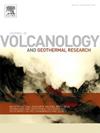Magma ascent dynamics and transport process of the Mt. Semeru lava dome that collapsed on 4th December 2021 (East Java, Indonesia)
IF 2.3
3区 地球科学
Q2 GEOSCIENCES, MULTIDISCIPLINARY
Journal of Volcanology and Geothermal Research
Pub Date : 2025-08-21
DOI:10.1016/j.jvolgeores.2025.108432
引用次数: 0
Abstract
This study aimed to discuss the magma ascent dynamics and transport process of the Mt. Semeru lava dome that collapsed on 4th December 2021 by coupling the field data with analysis of crystal textures (phenocrysts and microlites) and whole-rock geochemistry of clasts embedded in the 2021 pyroclastic density currents (PDCs) of the channel facies. We identify four clast types within the channel PDC facies, namely vesicular-black and porphyritic (V-BP), dense-grey and porphyritic (D-GP), dense-grey and highly porphyritic (D-GhP), and vesicular-reddish and weakly porphyritic (V-RwP). The V-BP, D-GP, and D-GhP clasts are free of olivine, having identical phenocryst size distribution (avg. slope − 3.0) and whole-rock composition of high Zr/Y basaltic andesites (∼56.5 wt% SiO2; Magma A). Meanwhile, the V-RwP clast includes some olivine, has a characteristically steeper slope of the phenocryst crystal size distribution (CSD) (−3.8), and is classified as low Zr/Y basalt (∼51 wt% SiO2; Magma B). This evidence suggests the occurrence of at least two magma reservoirs beneath Semeru. Judging from Semeru's historical record, dome formation via the extrusion of Magma A took place between 2004 and 2012, while Magma B was extruded before dome formation (between 1941 and 1994) and produced lava flows and V-RwP clasts; the latter was carried by the 2021 PDCs and thus classified as accidental lithics. The V-BP yielded the steepest CSD slope of plagioclase microlites (−50.8), followed by D-GP (−43.7) and D-GhP (−24.3), suggesting that the type A magma ascended and quenched at different rates. The less porphyritic and more gaseous magma quickly reaches the surface, resulting in V-BP with relatively small microlite size and steeper CSD. While the more porphyritic and gas-poor magma ascends slowly, resulting in slower cooling and thus facilitating the microlites to attain a larger size with gentler microlite CSD. The increasing SO2 emissions and the presence of harmonic tremors before the collapse event suggest that the dome was destabilized by the ascending magma, forming initially hot PDCs. However, heavy rainfalls (∼15 mm/h) successfully turned the PDCs into wet and cold (<100 °C) conditions, as evidenced by the prevalence of accretionary lapilli in the overbank facies and unsinged trees and wooden and plastic materials.
2021年12月4日崩塌的塞默鲁山熔岩穹丘岩浆上升动力学及运移过程(印度尼西亚东爪哇)
本研究旨在结合现场数据,结合通道相火山碎屑密度流(PDCs)中嵌入的晶体结构(斑晶和微晶岩)和全岩地球化学分析,探讨2021年12月4日崩塌的sememeru火山熔岩穹丘的岩浆上升动力学和搬运过程。在河道PDC相中,确定了4种碎屑类型,即泡状黑色斑岩(V-BP)、密灰色斑岩(D-GP)、密灰色高斑岩(D-GhP)和泡状红色弱斑岩(V-RwP)。V-BP, D-GP和D-GhP碎屑不含橄榄石,具有相同的斑晶尺寸分布(平均坡度- 3.0)和高Zr/Y玄武质安山岩的全岩组成(~ 56.5 wt% SiO2;岩浆A)。同时,V-RwP碎屑中含有部分橄榄石,斑晶粒度分布(CSD)斜率较陡(−3.8),属于低Zr/Y玄武岩(~ 51 wt% SiO2;岩浆B)。这一证据表明塞默鲁地下至少存在两个岩浆库。从sememeru的历史记录来看,岩浆A在2004年至2012年之间通过挤压形成穹丘,而岩浆B在穹丘形成之前(1941年至1994年)被挤压,并产生熔岩流和V-RwP碎屑;后者由2021型pdc携带,因此被归类为意外岩屑。V-BP的斜长石微长岩CSD斜率最大(- 50.8),其次是D-GP(- 43.7)和D-GhP(- 24.3),说明A型岩浆的上升和淬灭速率不同。斑岩岩浆较少,气态岩浆较多,迅速到达地表,形成微岩尺寸较小、CSD较陡的V-BP。而更多的斑岩质和贫气岩浆上升缓慢,导致较慢的冷却,从而有利于微岩达到较大的尺寸,微岩CSD更温和。在崩塌事件发生之前,SO2排放量的增加和谐波震动的存在表明,圆顶被上升的岩浆破坏了稳定,形成了最初的热pdc。然而,强降雨(~ 15毫米/小时)成功地将PDCs转变为潮湿和寒冷(<100°C)的条件,河岸相和未烧焦的树木、木材和塑料材料中普遍存在的增生石证明了这一点。
本文章由计算机程序翻译,如有差异,请以英文原文为准。
求助全文
约1分钟内获得全文
求助全文
来源期刊
CiteScore
5.90
自引率
13.80%
发文量
183
审稿时长
19.7 weeks
期刊介绍:
An international research journal with focus on volcanic and geothermal processes and their impact on the environment and society.
Submission of papers covering the following aspects of volcanology and geothermal research are encouraged:
(1) Geological aspects of volcanic systems: volcano stratigraphy, structure and tectonic influence; eruptive history; evolution of volcanic landforms; eruption style and progress; dispersal patterns of lava and ash; analysis of real-time eruption observations.
(2) Geochemical and petrological aspects of volcanic rocks: magma genesis and evolution; crystallization; volatile compositions, solubility, and degassing; volcanic petrography and textural analysis.
(3) Hydrology, geochemistry and measurement of volcanic and hydrothermal fluids: volcanic gas emissions; fumaroles and springs; crater lakes; hydrothermal mineralization.
(4) Geophysical aspects of volcanic systems: physical properties of volcanic rocks and magmas; heat flow studies; volcano seismology, geodesy and remote sensing.
(5) Computational modeling and experimental simulation of magmatic and hydrothermal processes: eruption dynamics; magma transport and storage; plume dynamics and ash dispersal; lava flow dynamics; hydrothermal fluid flow; thermodynamics of aqueous fluids and melts.
(6) Volcano hazard and risk research: hazard zonation methodology, development of forecasting tools; assessment techniques for vulnerability and impact.

 求助内容:
求助内容: 应助结果提醒方式:
应助结果提醒方式:


